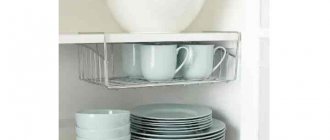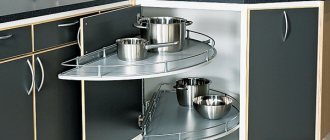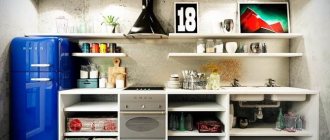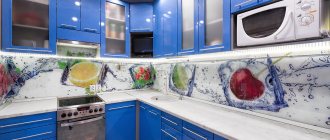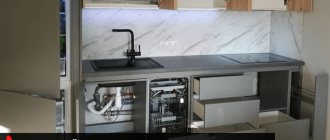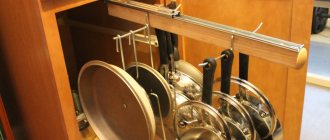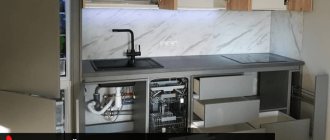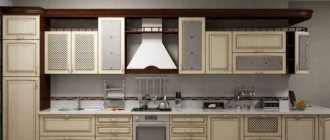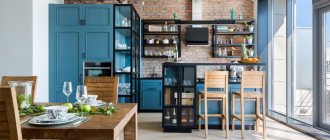<
>
Any housewife has a whole arsenal of cutlery in her kitchen - spoons, forks, knives, spatulas, ladles, corkscrews, butter brushes and many other useful little things for meals and cooking.
And the more there are, the more difficult it is to find the right item on time. To organize rational and convenient storage of cutlery, use separate furniture compartments in the form of drawers.
We take care of convenience in advance
Ideally, you should ask yourself the question of organizing your kitchen space not even when purchasing a set of furniture and household appliances, but even earlier - during renovation. It is when the decision is made about where the sink, heating radiators, sockets, lamps, and so on will be located.
There are no universal kitchens. Their appearance and content depend on the tastes and lifestyle of the owners: how many people are in the family, how much food they store, how many dishes and other items they have. It is important to consider how often they will cook in the kitchen and who exactly will do it - this is necessary in order to make the space the most ergonomic specifically for this person. For example, shorter-than-average height people will benefit from a lower work desk and sink.
The opportunity to organize space remains even when the kitchen renovation has already been done. You don’t have to completely remodel the furniture—it’s enough to improve its internal contents—add shelves, drawer dividers, and organizers.
Today there are a large number of modern mechanisms - door closers, lifting fasteners for facades and other things.
Lift mount makes access to upper cabinets easy
Traditional and new storage systems
The decisive factor for convenience is not how many cabinets you have in your kitchen, but how everything is organized in them. There are systems that will help you arrange various containers and kitchen utensils as compactly as possible. At the same time, they make it very easy to access the things you need. Modern headsets use the following systems:
- Roll-out boxes and baskets . Their advantage is that they allow you to view all the contents at once. They can be of different shapes and heights - cutlery and cooking utensils are stored in low ones, tableware in high ones, and even pots can fit in the largest drawers. You can store both food and textiles in the drawers. The main thing is that they slide out without much effort on your part. Dividers that are easy to make with your own hands will help organize storage inside the drawers.
IMPORTANT . Drawers need space not only inside the unit, but also outside - so that they can be pulled out completely and still stand next to them. This principle is true for hinged cabinets, ovens, and dishwashers.
- "Carousels". Useful devices that make it easier to access the most hidden places in corner cabinets. These are movable shelves strung on a rod inside the module. “Carousels” can be semicircular or round. The semicircular ones slide out on their own when the door is opened. The round ones are inside the cabinet. They are usually located in the lower sections. On such shelves you can store quite heavy items - large frying pans, pancake pans, pots and lids, canned food in jars.
ATTENTION. “Carousel” cannot be installed under the sink, as there is a drainpipe located here.
- Cargo, or bottle holders. Narrow, but at the same time tall, retractable metal baskets. They can be installed where there is not enough space for wide sections. Bottle holders are convenient for storing bottles with vegetable oils, sauces and drinks, and groceries in jars.
- Stationary drying, consisting of racks and a tray. If the cabinet does not have a bottom, a pallet is not required. This, on the one hand, is more convenient - the dishes dry faster. On the other hand, drips from dishes falling into the sink can be annoying.
Box lined with paper
Everything is fine at home. Here's a good idea for kitchen drawers - a large sheet of scented paper that you can put on the bottom.
- Everyday utensils and knives are in the foreground.
- Party supplies are in the deep end. Except for the gold-plated alligator-shaped cheese knives: these should be the center of attention.
- Measuring spoons - in appropriate size containers.
Where to store vegetables
It is good to keep many fruits and vegetables in the refrigerator, in a special drawer, where a suitable temperature is maintained. We will devote a separate article to storing various products in the refrigerator. And here we will focus on other places that are ideal for vegetables:
| Storage space for vegetables | Advantages | Flaws |
| Refrigerators, built-in or free-standing | It is compact, vegetables can be stored in it for as long as possible | The cost of this technology is quite high |
| Thermal cabinet | Suitable for large volumes of vegetables and home canning | Doesn't fit in a small kitchen. Expensive. Not everyone needs it |
| Wardrobe “refrigerator” under the windows | Does not require connection to an electrical outlet | Such “refrigerators” have been preserved only in some old houses. In the summer, they become completely ordinary cabinets. |
| Pantry | In addition to vegetables, it will fit many other products and things | It is not always possible to do it |
| Cellar | It’s always cool and dark here - not only vegetables and fruits love it, but also wines, canned food, and some other products | Available only in private houses or on the first floors of some high-rise buildings, however, in the latter it is quite rare |
| Pull-out metal baskets | They take up little space and are at hand. They can be replaced with wicker or plastic baskets, placing them on shelves. | They are at room temperature. |
| Rack against the wall or whatnot on wheels | Beautiful, comfortable | They require additional space |
| Canvas bags | Good for storing root vegetables. Lets air through. They don’t take up space—the empty bag can be folded compactly. | Vegetables in them are difficult to sort by type |
Several life hacks for storing vegetables in the kitchen:
- Before storing fruits and vegetables in a drawer or refrigerator, do not wash them.
- Store different types of vegetables and fruits separately.
- Ensure good air circulation in containers.
Vegetables in special bags will not expire prematurely
Liquid products: vegetable oil, canned food and honey
Let's put things in order on the shelves with glass and tin containers with liquid products: jam, compotes, canned vegetables, honey and oils. Most of them are stored in the back corners of closets or in a separate pantry. But there must be something at hand.
Canned food likes temperatures from 3 to 8 degrees Celsius, but they are often stored at room temperature - this is only permissible for closed cans. The main thing is that the place is not too wet.
ADVICE. No matter how beautiful the jars of canned food are, you should not store them in plain sight for a long time - they will quickly deteriorate from exposure to light. To decorate the interior of kitchens, special decorative canned food is made in jars and bottles of interesting shapes. For such preservation, several times more salt and vinegar are used, so it is unsuitable for food.
Honey can be stored for ages at temperatures no higher than 20 degrees Celsius. He also needs a secluded dark corner.
An airtight jar will ensure the safety of honey
It is preferable to keep vegetable oils in glass bottles, in a dark place, away from the stove - so as not to heat up. If they are in plain sight, put them in nice bottles and try to use them within a month. Some oils need to be refrigerated after opening.
If you are used to keeping oil in sight, pour it into an unusual but grippy bottle
Bulk products: cereals, tea and coffee
Finding beautiful jars is not a problem. But you shouldn’t buy the first containers you come across. They must have the following qualities:
- Convenient form . Rectangular jars can be placed tightly without leaving any “air” in the cabinet or shelf. Cylindrical ones are more ergonomic.
- Tight lid. It will prevent moisture and air from penetrating inside. In this case, the can should open without much effort.
- Material suitable for food storage. We do not recommend purchasing containers made of plastic of suspicious quality - they have their own smell that can absorb food. In addition, such material can be toxic. Wooden boxes absorb food odors and are suitable for storing only one type of cereal. Tin cans look cute and are lightweight. And the most durable and environmentally friendly are containers made of glass and ceramics. Unless, of course, you drop them.
Opaque cans and boxes are recommended to be signed. To do this, you can use special stickers with the names of the products or plain stickers that you sign yourself.
It is customary to put spices in small jars - this is the cutest way to store them. We will talk about this in more detail in another article.
Bulk cans form a single “ensemble” - you shouldn’t hide such sets behind cabinet doors
An alternative to jars is bags with zip fasteners. And if you like to store food in store-bought packaging, you will need clothespins or clips, as well as baskets where all the packages will stand vertically, supporting each other. Note that this method does not guarantee long-term preservation of products - it is suitable for those who purchase small packages and use them quickly.
ADVICE. Don't fill your closets 100%. If there is no space left in them, it will be inconvenient to put things in and take them out.
For tea in sealed bags, jars with tight lids are not needed - such a “house” will be enough
Drawer without junk
Absolutely all the drawers for small items are filled with real rubbish, which can be safely thrown away, and for what remains, just find a new place.
- Unpacked batteries are always stored separately: this is safe.
- For wires, small items, clothespins and clips - separate containers.
- Flashlights and large items are placed around the edges and secured in place by the organizer.
Where to put dishes and cutlery
The drawers or shelves on which dishes are stored can always be improved. And if there is not enough space, stands and other accessories will come to the rescue.
Storing pans and pots
For large dishes, special racks and hanging systems are suitable. Dividers for large drawers are also used. The lids can be folded there or on a stand designed for this purpose.
Pans can be hung like this...
...or like this
Pans on such a rack can be placed inside a large cabinet
buybuy
Sets of pans are the most compact, as they are usually nested inside each other like a nesting doll
Organizers for knives, spoons and forks
To keep knives at hand, attach a magnetic strip for them above the work area. If you have space on your work surface, purchase a set of knives in special stands.
buybuy
Knives on a magnetic holder: such sets are very space-saving
Spoons and forks, as well as knives and various cooking utensils - spatulas, whisks, ladles - can be conveniently stored in a shallow drawer with a divider. But there are other ways - place the cutlery in a metal bucket and hang it on the rail.
A few simple rules
Everything has its place. Let everything lie in its usual places: pots on one, spoons on another. Don't move things around.
Let everything be in plain sight. Line up the products you need in front. The rest - move higher. Hang pots and pans on hooks, kitchen utensils on a metal string, and keep knives on a special stand (so they don’t touch and become dull).
Place food in small containers. Flour, sugar, starch: food in containers looks neat and stylish.
Buy cookware from restaurant supply stores. This way, you'll have items that will last: cutting boards, white plates, and stainless steel pans.
Little things. Hooks and metal clips help keep scissors, coffee filters, and dish brushes handy.
Glory to the trays. Trays can be used throughout the house, but are best placed near the sink and stove. They are very practical (they can be carried and easily washed) and aesthetically pleasing (simple objects grouped on a tray turn into a still life). You can stack trays on top of each other to accommodate small items.
We remove boards, towels and sponges
In addition to food, dishes and utensils, a household needs many more things. Now let's deal with them in order to restore perfect order in the kitchen.
Cutting boards
Small boards fit perfectly into an office paper organizer - both horizontal and vertical. It can be placed on a table or in a closet.
Boards with holes can be hung on the wall.
There are no problems with space for cutting boards if they have their own “native” box
buybuy
And such matryoshka boards have their own stand and are used as decoration
Napkins and towels
Towels and textile napkins are often hung on the oven handle or on the radiator - there they dry faster. But they will look neater on hooks or on a rail, not far from the sink. Spare towels can be placed in wicker baskets.
Take inventory of your kitchen and get rid of unnecessary items
Remodelista We tell you what you need and what you should give up.
What you need
For the preparation of:
- Three knives: chef's, fruit and serrated.
- Two cutting boards (one for vegetables, one for meat).
- Peeler.
- Grater.
- Fine grater.
- Kitchen scissors.
- Opener.
- Colander.
- Wooden spoon.
- Spatula.
- Whisk.
- A pair of tweezers.
- Meat thermometer.
